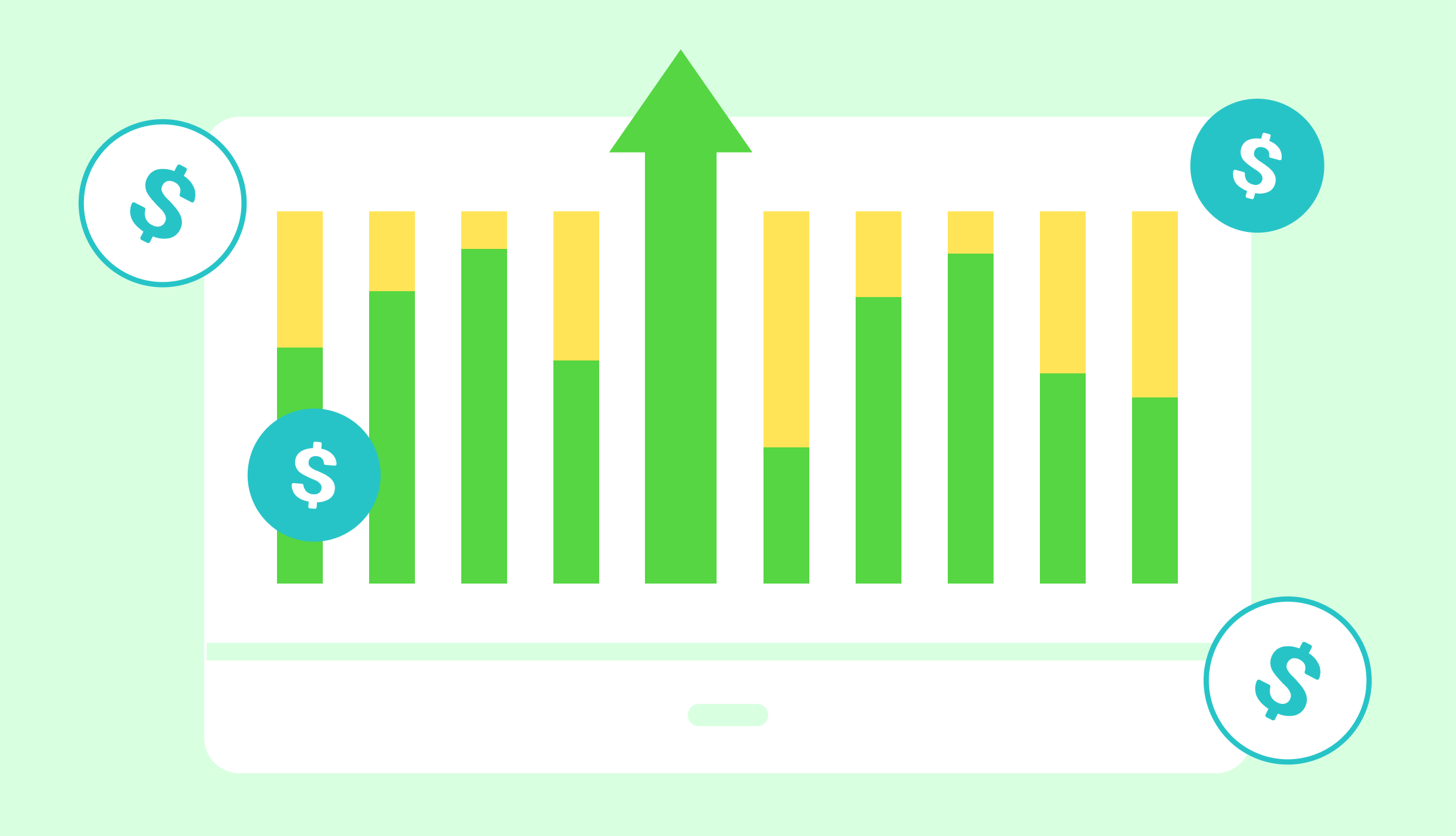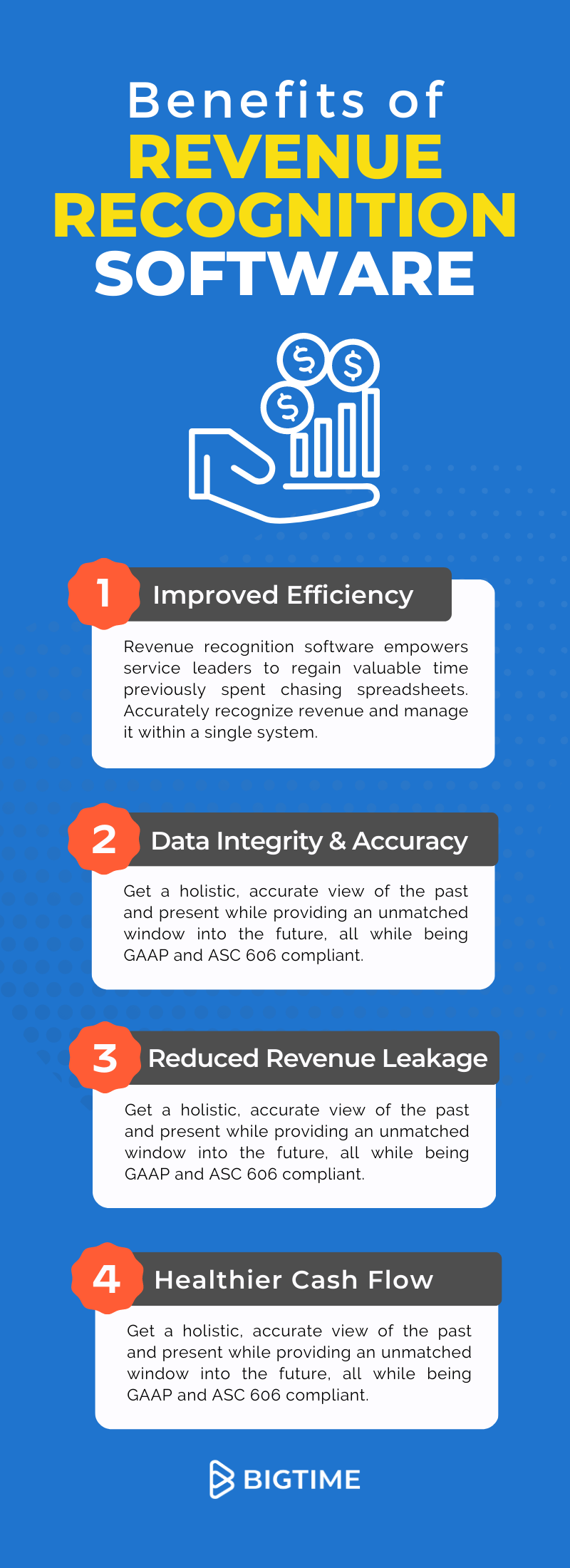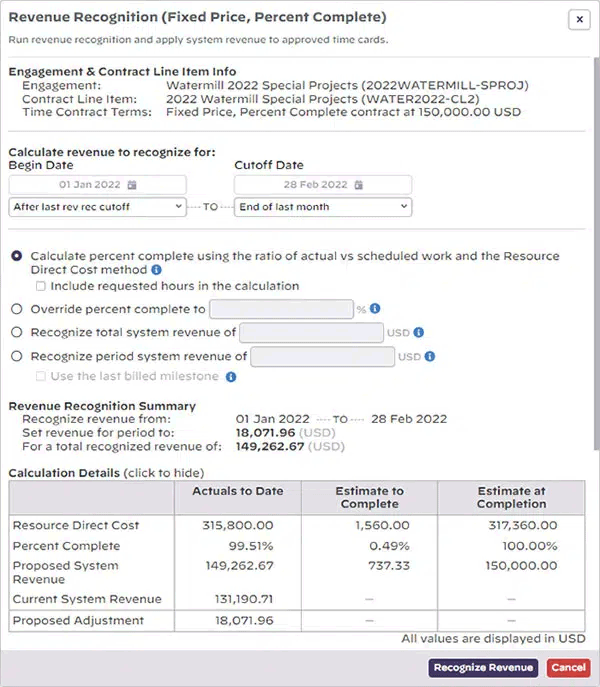
Most medium to large companies using accrual accounting utilize software for revenue management and recognition, along with supporting schedules typically done in spreadsheets. Often revenue recognition software is part of an accounting software package or an ERP (enterprise resource planning) solution. When it comes to revenue recognition for services organizations, it is important to understand the choices you have for software that will maintain GAAP (generally accepted accounting principles) compliance with regulations like ASC 606 while supporting your teams’ workflows.
This post explores 6 frequently asked revenue recognition questions that services teams should ask when thinking about revenue recognition software:
What is revenue recognition software?
Revenue recognition software helps organizations manage their revenue recognition process. It enables them to not only recognize historical revenues, but also to project future revenue in accordance with GAAP. Through revenue recognition automation, organizations can better manage their revenue recognition process and get critical access to real-time, accurate data and analytical tools necessary for making informed decisions about their financial status.
When is the right time to recognize revenue?
According to the FASB and generally accepted accounting principles (GAAP), revenue can be recognized when:
- The price can be determined
- Collection is probable
- There is persuasive evidence of an arrangement
- Delivery has occurred
When a services organization should recognize revenue can depend on the service contract type being utilized for a given project. Professional services contract types may include Time and Materials (T&M), Not to Exceed, and Fixed Price or some variation of these. Revenue recognition software is most commonly used with fixed price contract line items.
Service organizations can allocate project revenue manually or through a SaaS revenue recognition software solution such as Projector by BigTime. Projector by BigTime allows accounting professionals to use one of three revenue recognition options:
- Percent Complete
- Revenue Schedule
- Manual Revenue Recognition
Why is revenue recognition important and do professional services need revenue recognition software?
Consistent and accurate financial reporting, compliance with regulations and better decision making are just a few reasons why revenue recognition software is so critical for service firms. Revenue recognition software helps to ensure that an organization is compliant with all applicable laws and accounting regulations while optimizing operational efficiency.
When revenue recognition is part of an automated PSA solution (professional services automation), service businesses are able to make informed projections and forecasts and are better able to manage their business against budget.
How can revenue recognition software help?
Revenue recognition software can help streamline and improve numerous aspects of your service organization’s financial reporting. Benefits of revenue recognition software include:
- Improved efficiency: The best revenue recognition software ensures that all transactions are processed properly and in full compliance with GAAP rules and in accordance with the company’s revenue recognition policies and procedures. Time is saved and manual tasks are reduced. For example, posting journal entries and updating accounts receivable balances happen automatically, reducing human error – which leads to the next benefit…
- Data integrity: When using revenue recognition automation software, organizations get real-time visibility into critical revenue data, resulting in increased accuracy of data and improved consistency, reliability, timeliness and transparency. In Projector, users can easily view the contract type and contract timeline, the date through which revenue has been recognized, the amount of revenue recognized, and the revenue remaining to be recognized. Projector also shows who last ran revenue recognition and when they ran it.
- Reduced revenue leakage: Reducing revenue leaks due to underbilling, chargebacks, manual processes and lost or missing time is a key benefit of implementing a PSA tool with revenue recognition capabilities.
- Improved visibility: Automated revenue recognition reporting not only reduces revenue leaks, but service businesses are also able to make more informed forecasts and projections to improve results.

What should you look for when evaluating revenue recognition software solutions?
Revenue recognition is one of the cornerstones of accounting, as such it’s equally as critical to select the right revenue recognition software for your business needs. When evaluating revenue recognition tools, there are several factors to keep in mind:
- What does your current ecosystem look like and who has access to it?
- Do you have a current process in place that could be adapted to a new software, or would you need to completely overhaul your revenue recognition model?
- Can it integrate natively with your existing accounting system?
- Is the software designed with flexibility specific to your needs? Are you able to configure various elements to best suit your organization’s structure and workflows versus working with a cookie cutter approach?
- Is the software purpose-built for this type of service offering? Choosing a vendor whose software specializes in revenue recognition not only makes sense financially, but also saves you valuable time and effort.
How does a top PSA like Projector help with revenue recognition?
Revenue recognition adjustments may be necessary when clients have negotiated a limit in the amount of money they have agreed to pay for a particular engagement. In these cases, organizations need to pace the rate at which they recognize or earn revenue based on how much of the project has actually been completed, no matter when the actual payments for the work are made.
Projector by BigTime calculates the rate at which revenue is recognized such that at the end of the project, the full amount of revenue recognized is not more than the negotiated price cap. The rules for whether the final recognized revenue amount can be lower than the negotiated price cap are different depending on whether the contract was a fixed price or a time and materials with a cap agreement.
Here’s how Projector by BigTime computes the recommended revenue to recognize: Projector’s flexible architecture allows contracts to be broken into component parts but tracked at a contract level called the “engagement” level. Projector by BigTime calculates revenue recognition at an engagement level to correlate with the contractual agreement.

Revenue recognition in Projector by BigTime
One of the strengths of Projector by BigTime is that all necessary data to accurately recognize revenue is managed within a single system. This includes the amount of work on a project to date (via time cards) and how much work is projected in the future in order to complete the agreed upon scope (via booked hours). Since this data is maintained through the use of Projector on an ongoing basis, revenue recognition will be automatically enabled without the need for added steps (assuming the data is accurate and current prior to executing the revenue recognition process).
The actual process of managing revenue recognition in Projector by BigTime includes these steps:
- Determining the percent complete basis – A method needs to be determined that will be used to calculate what percent of the engagement is complete (this is done once for the entire organization).
- Specifying the engagement time contract terms – For engagements with fixed price time contract terms, a holdback amount needs to be determined (it could be zero) and the revenue recognition method needs to be specified (i.e., percent complete or revenue schedule).
- Updating outstanding work data – Service teams need to ensure that data is kept up-to-date as it pertains to the work still needed in order to complete the project.
Organizations need to set their own policies regarding how often to adjust their recognized revenue and for which projects this process should occur. Most professional services organizations and consulting firms perform revenue recognition one time in each accounting period, and the process can be performed if the accounting period it falls under is open or closed. Where revenue goes after the revenue recognition process, however, does depend on whether the accounting periods are open.
In Summary
To summarize, there are many factors to consider when selecting the best revenue recognition software for your services organization. Keys things to consider include how the software will work with your revenue recognition model, your current workflows and your current project accounting system.
Does the revenue recognition solution accommodate contract types you currently use as well as ones you may want to employ in the future? And will the cost of the tool return value from the start, and ROI within an acceptable timeframe? If you’re interested in considering a PSA as a SaaS revenue recognition tool, or if someone in your organization is evaluating PSA software, download our Professional Services Automation (PSA) Buyer’s Guide to get even more ideas for software evaluation and selection.
We invite you to reach out to us at any time with questions about BigTime Software’s robust capabilities for accounting, including project accounting, multi-office and multi-currency capabilities and, of course, detailed revenue recognition.
More Frequently Asked Questions About Revenue Recognition Software
What is revenue recognition software?
Revenue recognition software helps organizations manage their revenue recognition process. It enables them to recognize historical and projected revenue according to generally accepted finance and accounting rules like ASC 606.
What is a revenue recognition system?
Systems for revenue recognition manage monthly accounting tasks such as billing while keeping organizations in compliance with regulations around reporting revenue.
When do you recognize revenue recognition?
Two conditions must exist for a company to recognize revenue on its books: an event signaling a transaction has to happen (for example when merchandise or a project is sold) and payment for the product or service correlates to the price agreed upon.
What are some examples of revenue recognition?
A services firm agrees to provide a project based on time and materials. In month 1, the team spent 20 hours working on this at a billable rate of $250/hour—therefore, they can recognize $5,000 of revenue in month 1. In month 2, if the company spends 10 hours on this project, they can recognize $2,500 of revenue in month 2.
What is revenue recognition in ERP?
For companies with large budgets, ERP tools (enterprise resource planning) combine accounting, CRM, supply chain and more into a single solution. Professional Services Automation (PSA) software is a more affordable option for many services organizations.
What are the types of revenue recognition methods?
The main 5 types of revenue recognition are: sales basis, completion of earning and assurance of payment, percent complete, cost recoverability, and installment.
What is automated revenue recognition?
Automated revenue recognition software, like a PSA (professional services automation), aggregates the data in your organization in an automated process that’s compliant with generally accepted accounting principles (GAAP).
What is the key point of revenue recognition?
Proper revenue recognition performed using GAAP principles provides financial transparency and a truthful accounting of a company’s business performance.
Why is revenue recognition important to understanding cash flow in a service business?
Beyond simply knowing how much cash is available at a given time, revenue recognition provides visibility into what future cash flow a company can expect.
Why is revenue recognition a significant risk?
The risks associated with improper revenue recognition include: inflated or false financials, inaccurate reporting, and possibly even legal action or penalties for larger companies with obligations to shareholders or investors.


.png)


